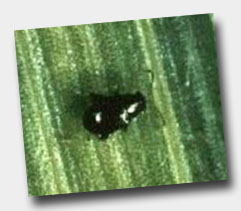Insect Factsheets
Black Cutworm
Chinch Bug
Corn Blotch Leaf Miner
Corn Flea Beetle
Corn Leaf Aphid
Corn Rootworm
European Corn Borer
Grasshoppers
Sap Beetles
Western Corn Rootworm
Wireworms
Disease Factsheets
Anthracnose Leaf Blight
Anthracnose Stalk Rot
Aspergillis Ear Rot
Bacterial Stalk Rot
Charcoal Rot
Common Rust
Common Smut
Corn Nematodes
Crazy Top
Diplodia Ear Rot
Diplodia Stalk Rot
Eye Spot
Fusarium Kernel Ear Rot
Fusarium Stalk Rot
Gibberella Red Ear Rot
Gibberella Stalk Rot
Gosss Bacterial Wilt Blight
Gray Leaf Spot
Holcus Spot
Maize Chlorotic Dwarf Virus
Maize Dwarf Mosaic Virus
Nigrospora Ear Rot Cob Rot
Northern Corn Leaf Blight
Northern Corn Leaf Spot
Penicillium Ear Rot
Physoderma Brown Spot
Pythium Stalk Rot
Red Root Rot
Seed Seedling Diseases
Sorghum Downy Mildew
Southern Corn Leaf Blight
Southern Rust
Stewarts Wilt
Home --> Field Crops -->
Corn
December Featured Fact Sheet: Corn Flea Beetle

Corn flea beetles are small, shiny, black beetles, approximately 1/16-inch long, with enlarged hind legs. Adults are easily disturbed and are known for their ability to jump long distances. The larvae are small, white, and not very active. Full-grown larvae are 1/6-inch long and most body segments are non- pigmented. Only the prothorax and the last abdominal segment are slightly darkened.
Click here to read more about Corn Flea Beetle